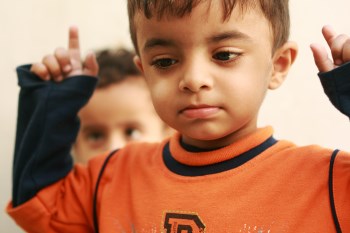 Instructions: Read the scenario. At the end, you will find related questions for reflection based on your role. Take a moment to reflect on each question.
Instructions: Read the scenario. At the end, you will find related questions for reflection based on your role. Take a moment to reflect on each question.
Scenario 2: Dance Moves
A teacher gets ready for a parent meeting with the family of a 3-year-old in her class. She has prepared by putting together a folder of the child's work. It includes examples of art projects, her own observations, and a series of photographs to show samples of her observations. She plans to share the materials with the family during their classroom visit.
The teacher has noticed that at times, particularly during outdoor activities, Jacob has a very particular way of moving. The teacher is not sure how to interpret this movement. At these times, he plays away from the group. He takes very slow, and what appears to her, unsteady steps, keeping his arms outward to both sides. He appears to try and balance himself even though he is on flat ground. At most other times though, he seems quick and confident when he moves. She wonders if this behavior is something to worry about, and if the parents have seen something similar at home.
In the meeting, the teacher and family talk about Jacob's development in many areas. When the conversation turns to his motor skills and movement development, the teacher shares her observations. "I have noticed that Jacob sometimes has a very unique way of moving. He plays at the edge of the group and appears to move very slowly and with purpose. He concentrates on the motions of his feet and arms, and seems to be trying very hard to balance. Do you ever notice anything like this at home?"
The parents look at each other, surprised. The father, looking puzzled, says, "No, I don't think I've ever noticed anything like that." He asks, "When have you seen this happen? Could you describe it more?"
The teacher shows the parents a series of photos she took to illustrate an example of the movement. The images show him moving along a wide flat wooden beam on the ground at the edge of the outdoor play area. Jacob has his arms extended out to his sides. He appears to be shuffling sideways with small steps, rocking slightly and carefully from side-to-side.
The teacher says, "I'm not sure how well you can see this example from this set of photos, but I think they might help you get a sense of what I've been observing. Do you see the look on this face?" She adds, "What concentration! He was moving very carefully with his arms out. It looked like he was trying to balance himself as he rocked back and forth. I have seen him move this way at other times, too, not only when he plays outside."
The boy's mother and father look at each other and begin to smile. His father turns toward the teacher and says, "Well, yes! This is actually very familiar." He pauses and says, "I recognized it right away from the pictures. Those movements look a lot like ones that come from a dance. Our children and families dance and sing together at gatherings and holidays. Recently, Jacob has begun to join some of the older boys and men in our community to learn some of our songs and dances."
He looks carefully at the teacher to observe how she responds. He pauses and then shares, "There is one dance in particular where children and adults stand shoulder-to-shoulder and move slowly. We time our steps together, reaching our arms to both sides. The dancers move and rock to the beat of the drummer and the voice of the singer." He adds with a smile, "It seems like he was trying out some of his new moves on the edge of the playground!" The mother smiles at the father, and they look at the teacher to see her reaction.
Reflections
Program Staff
- What approaches do you and other program staff use to share child observations with parents? How do you encourage family and parent reflections and conversation?
- Are you familiar with the communities to which your program's children and families belong? Do parents have planned ways to share community and cultural information with program staff and other families? Do you invite them to take the lead about when and what they share?
- What might make parents or families hesitate to share community or cultural information with staff or other families?
- Reflect on a time when you were curious about a child's unique behavior. How did you learn more? Did your discoveries change your relationship with the family or child? Were you surprised about what you learned?
- How might the information shared by the parents in this scenario inform the staff's approach to working with the child and family?
- What aspects of your personal culture or traditional practices differ from those of your colleagues or the families in your program?
Program Managers and Leadership
- How do program staff collect and document child observations that can be shared with families? How are these practices supported?
- Do children, families, and program staff have opportunities to learn about and share community and cultural traditions and information with each other?
- Do staff include individuals that belong to or have knowledge of the different backgrounds, cultures, and languages of the children and families enrolled in your program?
- Are there resources, organizations, or agencies in your community that support the cultural heritage of children, parents, and families enrolled in your program? If so, does your program build ongoing relationships with them?
« Go to Cultural Perspectives in Caregiving: Applying Relationship-Based Practices
Last Updated: July 29, 2019
